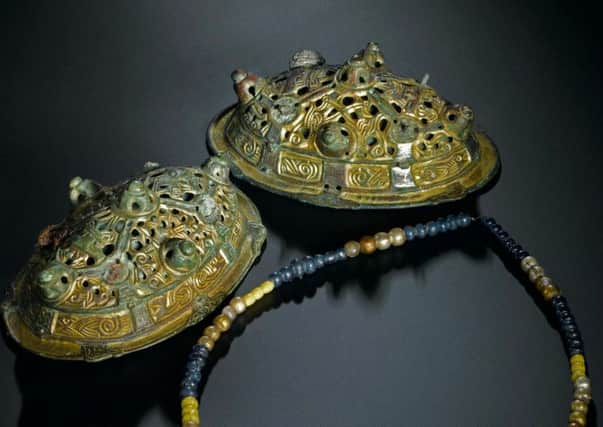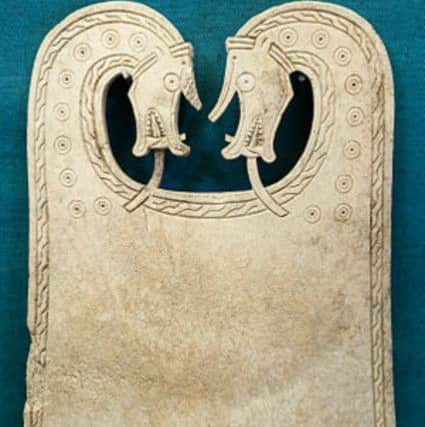Viking women enjoyed 'higher status' in Scotland


More Viking women were afforded high-status burials in Scotland when compared to other settlements in Britain and Ireland, it has been claimed.
Also, proportionately more women were laid to rest with grave goods, or burial objects, in Viking Scotland indicating that they had played a more “significant role” in society than first thought.


Advertisement
Hide AdAdvertisement
Hide AdThe ritual furnishings were at least as common in Scotland as in Norway - and perhaps even more prevalent, according to Dr Stephen Harrison, an expert in Viking graves at Glasgow University.
The findings “potentially” indicate that Viking women enjoyed leadership roles in Scotland, which was colonised in parts by the Vikings between the 8th and 15th Centuries, he added.
Dr Harrison said: “In the past it has been seen that males are buried with the objects where they have acquired through their raiding or trading and women have been buried with objects given to them by their men folk.


“Looking at Scottish burials, I have been exploring this idea that women had a far more significant role in early Viking settlements that we have previously thought.”
Dr Harrison’s research looked at around 140 Viking graves which contain burial objects in two main areas of Scotland. These span Caithness, Orkney and Shetland in the north and in the Hebrides to the west.
Males were typically buried with weapons and smithing tools while women were often laid to rest with oval brooches - which they wore in pairs on their shoulders - and tools relating to textile weaving and cloth making.
Around 100 graves in Scotland contain at least one of these “gendered” objects. About 60 of these are male graves, and 40 female.
Advertisement
Hide AdAdvertisement
Hide AdDr Harrison said: “If you were a man, you were much more likely to be buried with grave goods.
“But in Scotland, the proportion of women with grave goods was much higher.
“It’s difficult to get exact figures for Norway, but the evidence suggests that the proportion of women’s furnished graves in Scotland was at least as high as Norway, and may have been higher.”
Viking graves are associated with higher-status members of the settlement, it is now believed, with others buried without grave goods.
For every three male graves in Scotland there are two female ones, Dr Harrison said.
This represents a far higher proportion than the Isle of Man, for example, where there are 25 male graves for one female grave.
Dr Harrison said there were a number of sites in Scotland where the woman’s grave is the most “ritually furnished”.
Advertisement
Hide AdAdvertisement
Hide AdSometimes, there is only one grave - and it belongs to a woman, he added.
Dr Harrison said: “These cases would suggest that, in Scotland, for some reason , a woman’s grave can be seen as particularly significant.
“We have to be realistic. All of the sources tell us that Viking society was patriarchal but we do know that, in certain circumstances, that women have power and inherent power.
“But we are challenging stereotypes which have down played a woman’s role in Viking society.”
Major finds of Viking graves in Scotland were recorded at Scar, Orkney where a man, elderly woman and child were found in a burial boat in 1991.
Among the grave goods was a whalebone plaque, which some believe was used as a type of early ironing board. Others believe it could have been used as a chopping board or tray.
At Ballinaby on Islay, several items were found in graves in the late 19th Century, including brooches and a linen smoother, a small ball of glass used to remove creases from materials.
Advertisement
Hide AdAdvertisement
Hide AdDr Harrison said: “In Scotland, the Viking settlements were overwhelmingly rural and it is an economy which revolved around agriculture and fishing.
“Within that kind of society, women play a really, really important role and I think the burials reflect that important role.
“One aspect of this is textile production, it was a very important part of Viking life and key to the Viking economy.”
However, he added that the items relating to textile manufacture would not only be placed in the graves of those involved in the trade but would likely be left to denote the significance of the female being buried.
Dr Harrison added there was no evidence to suggest that shield maidens - or female warriors - existed in Viking culture, despite depictions in film and television.
“The fact that women don’t usually fight doesn’t means they don’t have power in Viking society. There were ways of women becoming powerful that didn’t involve fighting.”
